Digital Poster
Magnetization Transfer Imaging
ISMRM & ISMRT Annual Meeting & Exhibition • 10-15 May 2025 • Honolulu, Hawai'i

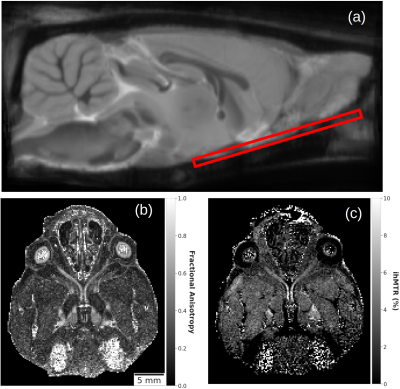 |
Computer Number: 49
2006. Optimization
of Inhomogeneous Magnetization Transfer Imaging on a Fully
Myelinated Tract
P. Labouré, F. Geffroy, L. Ciobanu
Neurospin, Gif-Sur-Yvette, France
Impact: This study enhances our understanding of ihMT’s
sensitivity and specificity to myelin, paving the way toward
optimized acquisition parameters and the development of a
standardized protocol.
|
|
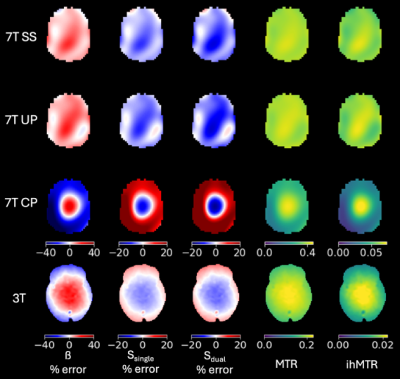 |
Computer Number: 50
2007. Universal
versus subject-specific parallel transmit pulses for
inhomogeneous magnetization transfer at 7T
M. Lam, V. Gras, M. Couch, C. Rowley, C. Tardif
McGill University, Montreal, Canada
Impact: To enable high-resolution whole-brain ihMT
imaging at 7T, we require dual and single off-resonance
pulses that produce a spatially uniform saturation. Our
simulations showed improved ihMT uniformity using
subject-specific and universal pre-saturation pTx pulses to
a range comparable to 3T.
|
|
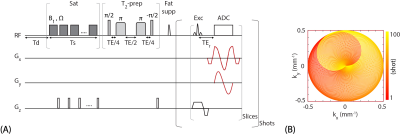 |
Computer Number: 51
2008. Simultaneous
measurement of water, MT, CEST, myelin water fraction, and
susceptibility contrast using rosette-accelerated MR
fingerprinting
S. Z. Mahmud, H-Y Heo
The Johns Hopkins University School of Medicine, Baltimore, United States
Impact: A rosette-accelerated, multi-parametric MRF
technique efficiently assesses various tissue parameters
that serve as candidate biomarkers, providing valuable
insights into a range of pathologies.
|
|
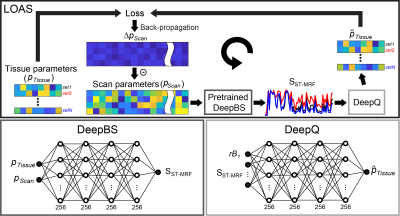 |
Computer Number: 52
2009. Optimization
of acquisition schedules and correction of B0 and B1 field
inhomogeneities in saturation transfer MR fingerprinting
(ST-MRF)
B. Kang, M. Singh, H. Seo, H. Park, H-Y Heo
Korea Institute of Science and Technology (KIST), Seould , Korea, Republic of
Impact: The proposed optimal ST-MRF approach could
provide accurate and reliable multi-tissue parameter maps
from a single scan within clinical acceptable time, even in
the presence of the severe B0 and
B1 field
inhomogeneities.
|
|
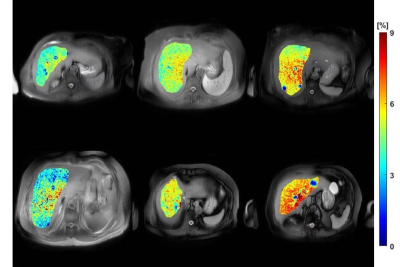 |
Computer Number: 53
2010. Quantitative
Macromolecular Proton Fraction Imaging using Pulsed Spin-Lock
Q. Shan, Z. Yu, B. Jiang, Q. Shen, J. Hou, Q. Chan, W. Chu,
V. Wong, W. Chen
The Chinese University of Hong Kong, Hong Kong, China
Impact: The technical can improve SNR of MPF-SL under
typical RF hardware constrain and provide more reliable and
robust MPF mapping in vivo.
|
|
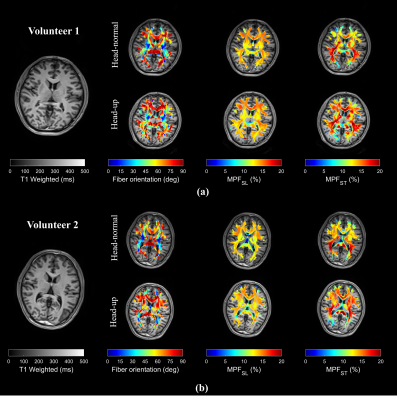 |
Computer Number: 54
2011. Orientation-independent
magnetization transfer measurement of white matter in brain
Z. Gao, Z. Zhou, Z. Yu, J. Hou, Q. Shan, W. Chen
The Chinese Univeristy of Hong Kong, Hong Kong, Hong Kong
Impact: The MPF-SL technique provides a potential
solution for orientation-independent magnetization transfer
measurement of white matter in human brain.
|
|
 |
Computer Number: 55
2012. Magnetization
Transfer Knee Imaging at 0.05 Tesla with Extremely Low SAR
S. Su, Y. Ding, V. Lau, J. Hu, J. Zhang, X. Lin, L. Wu, A.
Leong, Y. Zhao, E. Wu
The University of Hong Kong, Hong Kong SAR, China
Impact: MT
knee imaging is demonstrated at 0.05 Tesla for the first
time. Strong MT effects have been observed in articular
cartilage with an extremely low SAR of 3.1mW/kg, rendering
the potential of ULF MT knee imaging for articular cartilage
evaluation.
|
|
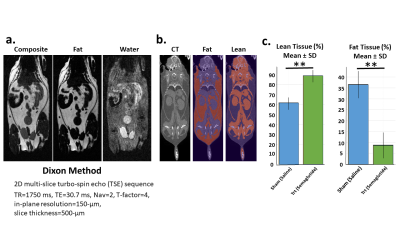 |
Computer Number: 56
2013. Impact
of Ozempic on Adipose Tissue in Obese Mice: A Quantitative Study
Using Dixon and MT MRI Methods, DEXA and CT.
O. Aristizabal, D. Abbadi, O. Mishkit, N. Rahman, R.
Schneider, Y. Zaim-Wadghiri
NYU Grossman School of Medicine, New York, United States
Impact: This study highlights an advanced MRI protocol's
potential for precisely assessing body composition, showing
that Semaglutide improves muscle health by increasing lean
tissue and reducing fat. This non-invasive imaging approach
could significantly enhance monitoring in metabolic health
interventions.
|
|
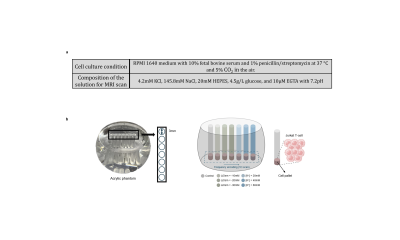 |
Computer Number: 57
2014. Investigation
on Water Dynamics in Cell Swelling
S-M Kim, K. Min, J. S. Lee, J-Y Park
Department of Intelligent Precision Healthcare Convergence, Sungkyunkwan University, Suwon, Korea, Republic of
Impact: This study elucidates the water dyanmics
associated with cell swelling using MRI, particualrly
showing differences between two different mechanisms of cell
swelling, which will contribute significantly to a better
understanding of cell physiology and function.
|
|
 |
Computer Number: 58
2015. Robust
extrapolated semi-solid magnetization transfer reference fitting
for amide proton transfer (APT) imaging quantification
J. Wu, K. Chai, P. Wang, Z. Zhang, J. Zhou, S. Jiang
Johns Hopkins University, Baltimore, United States
Impact: The
proposed method enabled more robust APT imaging
quantification, which provides stronger APT signal intensity
values than traditional MTR asymmetry analysis. Preliminary
results proved its effectiveness in distinguishing treatment
effect and tumor recurrence and more applications are
expected.
|
|
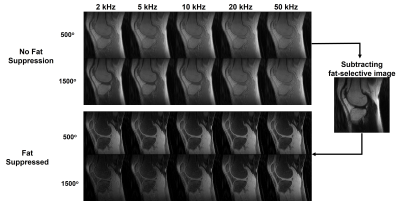 |
Computer Number: 59
2016. Fat-suppressed
ultrashort echo time magnetization transfer (UTE-MT) modeling
via subtraction of fat-selective image
S. H. Shin, A. Suprana, J. Lo, J. Wang, D. Berry, E. Chang,
J. Du, Y. Ma
UC San Diego, La Jolla, United States
Impact: The fat-suppressed UTE-MT method shown in this
study will improve the accuracy of quantifying molecular
compositions of short-T2 tissues. This fat suppression
method also has the potential to be applied to other
UTE-based quantitative MR techniques.
|
|
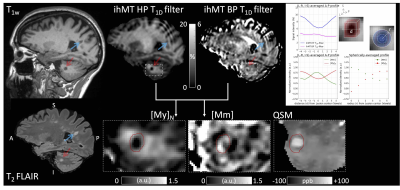 |
Computer Number: 60
2017. Investigating
ihMT T1D-filtering imaging for characterizing demyelination and
inflammation processes in MS lesions
G. Duhamel, T. Anderson, A. Hertanu, L. Soustelle, L. de
Rochefort, L. Pini, G. Varma, D. Alsop, J. Pelletier, O.
Girard
Aix Marseille Univ, CNRS, CRMBM, Marseille, France
Impact: Semi-quantitative measures of the density of
myelin and that of other macromolecules can be obtained with
a single MR experiment using ihMT T1D filtering.
This technique might be used to characterize demyelination
and processes of inflammation in MS lesions.
|
|
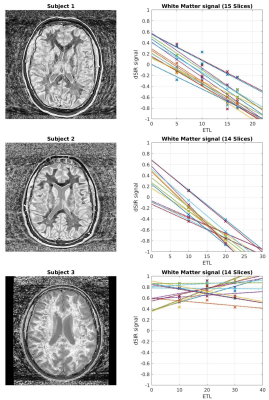 |
Computer Number: 61
2018. The
role of incidental magnetization transfer in divided subtracted
inversion recovery
M. Bydder, T. Melzer, N. Palmer, P. Condron, D. Cornfeld, E.
Kwon, M. Tayebi, G. Newburn, M. Scadeng, S. Holdsworth, G.
Bydder
Mātai Medical Research Institute, Gisborne, New Zealand
Impact: This study identifies a plausible mechanism for
dSIR signal changes in white matter that may lead to more
efficient methods of detecting mTBI and hypoxic injuries.
|
|
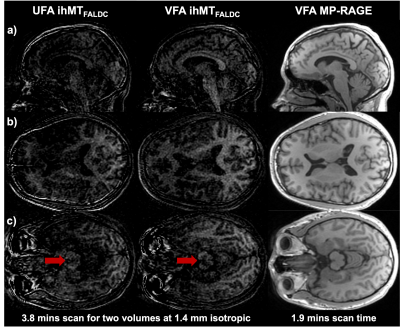 |
Computer Number: 62
2019. Reducing
ihMT acquisition time using alternating single frequency MT
preparation and variable flip angle readouts
G. Varma, A. Grant, L. Soustelle, O. Girard, G. Duhamel, D.
Alsop
Beth Israel Deaconess Medical Center, Harvard Medical School, Boston, United States
Impact: We demonstrate frequency alternating at low duty
cycle MT and variable flip angle readouts significantly
improve ihMT by reducing scan time and/or increasing
resolution. These developments allow for easier clinical
translation and will improve utility in neurological studies
of myelin.
|
|
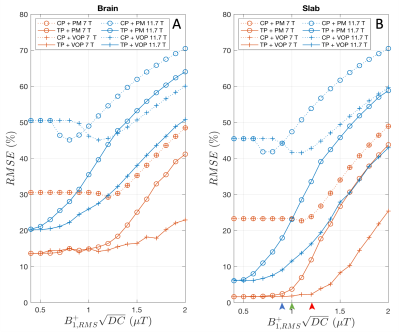 |
Computer Number: 63
2020. CEST
perspectives for human brain applications at 11.7 T
C. Ressam, V. Gras, F. Mauconduit, L. Ciobanu
NeuroSpin CEA Paris-Saclay, Université Paris-Saclay, Gif-sur-Yvette, France
Impact: This study explores the potential of using the
11.7 T scanner for human brain CEST applications, addressing
B1+ inhomogeneities
and SAR compliance. It marks a first step toward clinical
evaluation of CEST at magnetic fields higher than 7 T.
|
|
 |
Computer Number: 64
2021. Reproducible
liver CEST Imaging at 7 T with B1+ shimming
P. Bulanov, P. Menshchikov, J. Grimm, M. Lutz, S. Orzada, P.
Boyd, P. Bachert, M. Ladd, A. Korzowski, S. Schmitter
Division of Medical Physics in Radiology, German Cancer Research Center (DKFZ), Heidelberg, Germany
Impact: In this study, to the best of our knowledge, we
have successfully demonstrated for the first time the robust
and reliable acquisition of relaxation-compensated CEST
contrasts (i.e., MTRRex of amide, rNOE and guanidino) of the
human liver at ultra-high fields.
|
The International Society for Magnetic Resonance in Medicine is accredited by the Accreditation Council for Continuing Medical Education to provide continuing medical education for physicians.